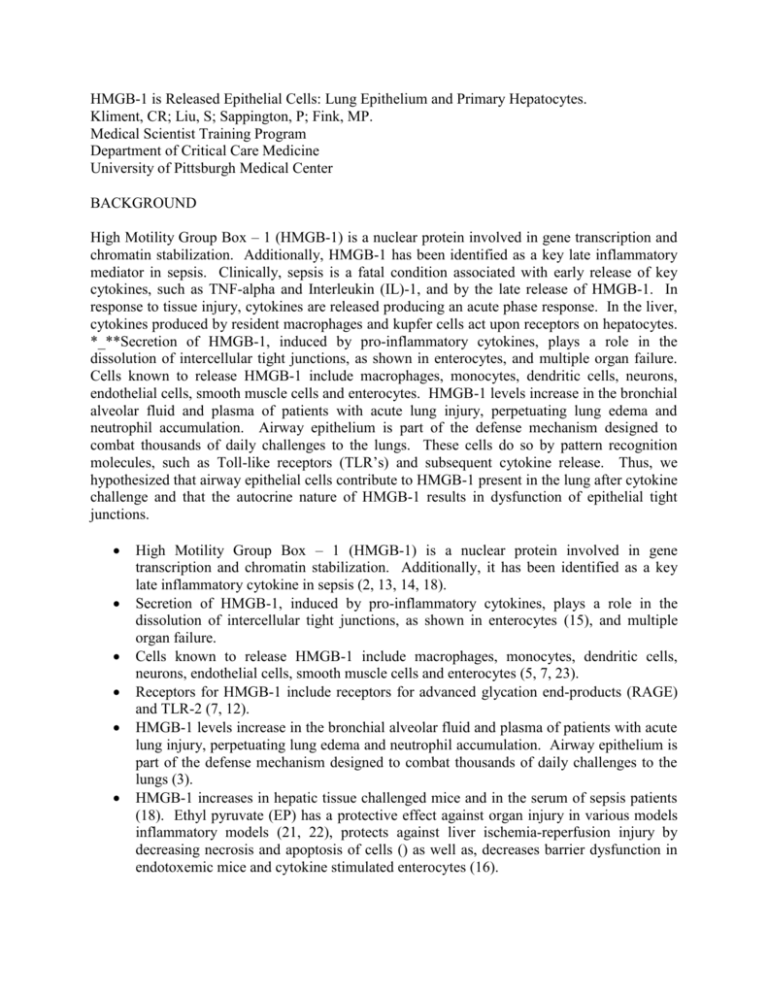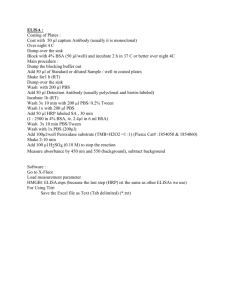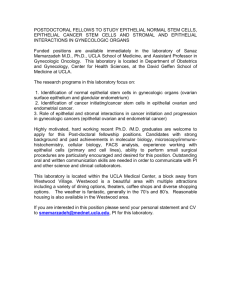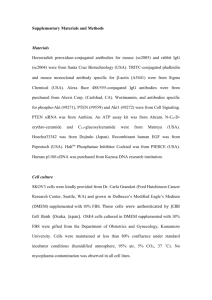METHODS - fink 05 - University of Pittsburgh
advertisement

HMGB-1 is Released Epithelial Cells: Lung Epithelium and Primary Hepatocytes. Kliment, CR; Liu, S; Sappington, P; Fink, MP. Medical Scientist Training Program Department of Critical Care Medicine University of Pittsburgh Medical Center BACKGROUND High Motility Group Box – 1 (HMGB-1) is a nuclear protein involved in gene transcription and chromatin stabilization. Additionally, HMGB-1 has been identified as a key late inflammatory mediator in sepsis. Clinically, sepsis is a fatal condition associated with early release of key cytokines, such as TNF-alpha and Interleukin (IL)-1, and by the late release of HMGB-1. In response to tissue injury, cytokines are released producing an acute phase response. In the liver, cytokines produced by resident macrophages and kupfer cells act upon receptors on hepatocytes. *_**Secretion of HMGB-1, induced by pro-inflammatory cytokines, plays a role in the dissolution of intercellular tight junctions, as shown in enterocytes, and multiple organ failure. Cells known to release HMGB-1 include macrophages, monocytes, dendritic cells, neurons, endothelial cells, smooth muscle cells and enterocytes. HMGB-1 levels increase in the bronchial alveolar fluid and plasma of patients with acute lung injury, perpetuating lung edema and neutrophil accumulation. Airway epithelium is part of the defense mechanism designed to combat thousands of daily challenges to the lungs. These cells do so by pattern recognition molecules, such as Toll-like receptors (TLR’s) and subsequent cytokine release. Thus, we hypothesized that airway epithelial cells contribute to HMGB-1 present in the lung after cytokine challenge and that the autocrine nature of HMGB-1 results in dysfunction of epithelial tight junctions. High Motility Group Box – 1 (HMGB-1) is a nuclear protein involved in gene transcription and chromatin stabilization. Additionally, it has been identified as a key late inflammatory cytokine in sepsis (2, 13, 14, 18). Secretion of HMGB-1, induced by pro-inflammatory cytokines, plays a role in the dissolution of intercellular tight junctions, as shown in enterocytes (15), and multiple organ failure. Cells known to release HMGB-1 include macrophages, monocytes, dendritic cells, neurons, endothelial cells, smooth muscle cells and enterocytes (5, 7, 23). Receptors for HMGB-1 include receptors for advanced glycation end-products (RAGE) and TLR-2 (7, 12). HMGB-1 levels increase in the bronchial alveolar fluid and plasma of patients with acute lung injury, perpetuating lung edema and neutrophil accumulation. Airway epithelium is part of the defense mechanism designed to combat thousands of daily challenges to the lungs (3). HMGB-1 increases in hepatic tissue challenged mice and in the serum of sepsis patients (18). Ethyl pyruvate (EP) has a protective effect against organ injury in various models inflammatory models (21, 22), protects against liver ischemia-reperfusion injury by decreasing necrosis and apoptosis of cells () as well as, decreases barrier dysfunction in endotoxemic mice and cytokine stimulated enterocytes (16). We hypothesized that various epithelial cells contribute to HMGB-1 produced after a challenge or injury to tissue. We looked specifically at airway epithelial cells, hypothesizing that they contribute to HMGB-1 present in the lung and that the autocrine nature of HMGB-1 results in dysfunction of epithelial tight junctions. We also hypothesized that hepatocytes, specialized epithelial cells of the liver, release HMGB-1 in response to stimulation. Because EP has been shown to be protective against liver injury, we belief that EP may inhibit the release of HMGB-1 by hepatocytes. METHODS Epithelial Cell Culture A549, alveolar type II lung epithelial cell line, and Calu-3, type I lung epithelial cell line, (ATCC) were cultured on 24-well collagen coated plates in Hams F12 supplemented media with 10% FBS and Penicillin/Streptomycin. Cells were stimulated with cytomix (10 ng/ml TNFalpha, 10 ng/ml IL-1B, and 1,000 U/ml IFN-gamma) or individual pro-inflammatory cytokines. Cell supernatants were collected after time course stimulation and HMGB-1 release was determined by direct sandwich ELISA. Cell viability was assessed using 0.1% trypan blue. HMGB-1 ELISA 96-well Nunc Maxisorp ELISA Immunoplates were coated with human monoclonal anti-HMG antibody (R&D Systems) at 1 g/ml in carbonate buffer, overnight at 4C, 50 l/well. Protocol for Carbonate Buffer, pH 9.6. Make the following stocks: A: 1M NaHCO3 (sodium bicarbonate) in ddH20, B: 1M NaC03 (sodium carbonate) in ddH20. To make 1L of carbonate buffer add 45.3ml of A and 18.2ml of B, bring up to 1L in ddH20. Sterile filter through 0.2um CA (cellulose acetate). The pH should be close or equal to 9.6. The plate was blocked with blocking buffer (PBS + 4% BSA) for 1 hr at 4C (200 l/well). HMGB-1 standards and samples (50 l/well) were incubated for 2 hrs at room temperature (RT). Recombinant full-length HMGB-1 was serially diluted from 1000 ng/ml - 0 ng/ml in blocking buffer. Wells were washed once with PBS, 200 l/well. Primary antibody detection was with rabbit polyclonal anti-HMGB (BD Sciences) at 1 g/ml, incubated for 1.5 hrs at 37 C (50 l/well). The plate was washed three times with fresh PBS + 0.2% Tween-20 for 10 minutes each, 200 l/well then washed once with PBS for 1 min, 200 l/well. Secondary Ab detection was with Fab’2 donkey anti-rabbit-HRP (Jackson Immunoresearch) at 1.5 – 3 ug/ml in blocking buffer (50 l/well), incubated for 1 hr at RT. The plate was washed three times with fresh PBS + 0.2% Tween-20 for 10 minutes each, 200 l/well then washed once with PBS for 1 min, 200 l/well. TMB peroxidase substrate (Pierce), mixed at equal parts, was used for color development for 15-30 minutes (blue), 100 l/well. The color reaction was terminated with 0.18 M Sulfuric acid (100 ul/well). Absorbance was read at 450 nm on a spectrophotometric plate reader. Epithelial Barrier Permeability Assay Calu-3 cells (Type I epithelia) were used to evaluate HMGB-1 release and tight junction function by monolayer permeability assays. Briefly, Calu-3 cells were cultured on transwell inserts to form complete monolayers. DMEM supplemented with Fluorescein isothiocyanate-labeled dextran (FD4) was sterile filtered and added to the apical compartment of the insert (200 l). Medium with or without HMGB-1 or cytomix was added to the basal compartment (500l). Cell supernatants were harvested after 24 hours. Spectrofluorometric analysis was completed on media from the basal compartment. Primary Hepatocyte Culture Primary rat hepatocytes were retrieved by in vivo hepatic collagenase perfusion. Retrieved cells were washed three times with Hank’s Balanced Salt Solution with Ca2+, centrifuged each time at 500 g for 5 minutes. Hepatocytes were further purified on a percoll centrifugation gradient. Cells were seeded onto 24 well collagen-coated plates with round glass slides for imaging, at a density of 250,000 cells/ml in William’s E medium with 10% FBS and Penicillin/Streptomycin. After incubation for 18-24 hours, cells were used for experiments. Cell Stimulation Cultured hepatocytes were washed once with serum-free William’s E media and fresh serum-free media was replaced. Cells received media alone, cytomix, Ethyl pyruvate (10 nM) or ethyl pyruvate plus cytomix for 6, 12, 24 or 36 hours. Cells receiving Ethyl pyruvate with and without cytomix were pre-treated with Ethyl pyruvate for 2 hrs, which remained on the cells for the subsequent incubation period. Cytomix was added for the corresponding time span. Supernatants were collected and centrifuged at 800 g for 5 minutes, 4C. HMGB-1 was determined by ELISA. Exosome Collection and Immunohisto-Staining for HMGB-1 Hepatocytes were cultured on collagen-coated slides, as described above. Supernatants were collected and centrifuged at 800 g for 5 minutes to retrieve exosomes. Cells were fixed for 1 hour with 2% paraformaldehyde at 4C, washed once with cool PBS and stored in PBS for fluorescent staining. Exosome analysis, immunohistochemisty and cell imaging was completed by Donna Beers-Stolz, University of Pittsburgh Cell Biology and Physiology Department. Immunofluorescence confocal microscopy Fixed cells on slides were washed three times in PBS, then tree times (5 minutes each) with PBS supplemented with 0.5% bovine serum albumin (PBB). Cells were permeabilized in 0.1% Triton-X-100 in PBB for 30 minutes, then washed once with PBS containing 0.5% bovine serum albumin and 0.15% glycine (PBG). Cells were blocked with 2% bovine serum in PBS for 40 min then washed once with PBB. Rabbit anti-HMGB1 antibodies (1:2,000) were added to cells in PBB incubated at room temperature for 1 hr. Cells were washed four times in PBB then secondary antibodies (goat anti-rabbit Alexa 488, 1:500 dilution; Molecular Probes, Eugene, OR), rhodamine-phalloidin (1:250 dilution; Molecular Probes) and the nuclear dye, Draq5 (1:1000 dilution; Biostatus, Leicestershire, UK) were added for 1 hr at room temperature. Cells were washed three times in PBB then three times in PBS. Cells were mounted using gelvatol (23 g polyvinyl alcohol 2000, 50 ml glycerol, 0.1% sodium azide to 100 ml PBS). Cells were then viewed on a confocal scanning fluorescence microscope (Olympus Fluoview 1000, Malvern, NY). Results/Conclusion Lung epithelium releases HMGB-1 after stimulation with pro-inflammatory cytokines, specifically TNF-alpha, IL-1-beta, and IFN-gamma. Our findings suggest that epithelial cells participate in the production of HMGB-1 in the lung milieu, further contributing to barrier dysfunction of the lung in sepsis and septic shock. The liver receives all of the blood as it flows through the body. Therefore, it seems logical that the specialized cells of this organ respond to injury by producing many inflammatory cytokines, including HMGB-1 as we have presented. Future investigation includes further evaluation of the expression of HMGB-1 in other epithelial cells such as kidney. Additional hepatocyte experiments need to be conducted to confirm the secretion of HMGB-1 in exosomes and possible re-uptake processes by hepatocytes. After hepatic ischemia/reperfusion injury in mice, HMGB-1 tissue concentrations increase in a biphasic , time-dependent manner (19, 20). REFERENCES 1. 2. 3. 4. 5. 6. 7. 8. 9. 10. 11. 12. 13. 14. 15. Abraham, E., J. Arcaroli, A. Carmody, H. Wang, and K. J. Tracey. 2000. HMG-1 as a mediator of acute lung inflammation. J Immunol 165:2950. Andersson, U., H. Erlandsson-Harris, H. Yang, and K. J. Tracey. 2002. HMGB1 as a DNA-binding cytokine. J Leukoc Biol 72:1084. Bals, R., and P. S. Hiemstra. 2004. Innate immunity in the lung: how epithelial cells fight against respiratory pathogens. Eur Respir J 23:327. Bonaldi, T., F. Talamo, P. Scaffidi, D. Ferrera, A. Porto, A. Bachi, A. Rubartelli, A. Agresti, and M. E. Bianchi. 2003. Monocytic cells hyperacetylate chromatin protein HMGB1 to redirect it towards secretion. Embo J 22:5551. Chen, G., J. Li, M. Ochani, B. Rendon-Mitchell, X. Qiang, S. Susarla, L. Ulloa, H. Yang, S. Fan, S. M. Goyert, P. Wang, K. J. Tracey, A. E. Sama, and H. Wang. 2004. Bacterial endotoxin stimulates macrophages to release HMGB1 partly through CD14- and TNF-dependent mechanisms. J Leukoc Biol 76:994. Dumitriu, I. E., P. Baruah, A. A. Manfredi, M. E. Bianchi, and P. Rovere-Querini. 2005. HMGB1: guiding immunity from within. Trends Immunol 26:381. Dumitriu, I. E., P. Baruah, M. E. Bianchi, A. A. Manfredi, and P. Rovere-Querini. 2005. Requirement of HMGB1 and RAGE for the maturation of human plasmacytoid dendritic cells. Eur J Immunol 35:2184. Han, X., M. P. Fink, R. Yang, and R. L. Delude. 2004. Increased iNOS activity is essential for intestinal epithelial tight junction dysfunction in endotoxemic mice. Shock 21:261. Han, X., M. P. Fink, T. Uchiyama, R. Yang, and R. L. Delude. 2004. Increased iNOS activity is essential for hepatic epithelial tight junction dysfunction in endotoxemic mice. Am J Physiol Gastrointest Liver Physiol 286:G126. Han, X., M. P. Fink, T. Uchiyama, R. Yang, and R. L. Delude. 2004. Increased iNOS activity is essential for pulmonary epithelial tight junction dysfunction in endotoxemic mice. Am J Physiol Lung Cell Mol Physiol 286:L259. Han, Y., J. A. Englert, R. Yang, R. L. Delude, and M. P. Fink. 2005. Ethyl pyruvate inhibits nuclear factor-kappaB-dependent signaling by directly targeting p65. J Pharmacol Exp Ther 312:1097. Kokkola, R., A. Andersson, G. Mullins, T. Ostberg, C. J. Treutiger, B. Arnold, P. Nawroth, U. Andersson, R. A. Harris, and H. E. Harris. 2005. RAGE is the major receptor for the proinflammatory activity of HMGB1 in rodent macrophages. Scand J Immunol 61:1. Lotze, M. T., and K. J. Tracey. 2005. High-mobility group box 1 protein (HMGB1): nuclear weapon in the immune arsenal. Nat Rev Immunol 5:331. Rovere-Querini, P., A. Capobianco, P. Scaffidi, B. Valentinis, F. Catalanotti, M. Giazzon, I. E. Dumitriu, S. Muller, M. Iannacone, C. Traversari, M. E. Bianchi, and A. A. Manfredi. 2004. HMGB1 is an endogenous immune adjuvant released by necrotic cells. EMBO Rep 5:825. Sappington, P. L., R. Yang, H. Yang, K. J. Tracey, R. L. Delude, and M. P. Fink. 2002. HMGB1 B box increases the permeability of Caco-2 enterocytic monolayers and impairs intestinal barrier function in mice. Gastroenterology 123:790. 16. 17. 18. 19. 20. 21. 22. 23. Sappington, P. L., X. Han, R. Yang, R. L. Delude, and M. P. Fink. 2003. Ethyl pyruvate ameliorates intestinal epithelial barrier dysfunction in endotoxemic mice and immunostimulated caco-2 enterocytic monolayers. J Pharmacol Exp Ther 304:464. Stolz, D. B., R. Zamora, Y. Vodovotz, P. A. Loughran, T. R. Billiar, Y. M. Kim, R. L. Simmons, and S. C. Watkins. 2002. Peroxisomal localization of inducible nitric oxide synthase in hepatocytes. Hepatology 36:81. Sunden-Cullberg, J., A. Norrby-Teglund, A. Rouhiainen, H. Rauvala, G. Herman, K. J. Tracey, M. L. Lee, J. Andersson, L. Tokics, and C. J. Treutiger. 2005. Persistent elevation of high mobility group box-1 protein (HMGB1) in patients with severe sepsis and septic shock. Crit Care Med 33:564. Tsung, A., R. Sahai, H. Tanaka, A. Nakao, M. P. Fink, M. T. Lotze, H. Yang, J. Li, K. J. Tracey, D. A. Geller, and T. R. Billiar. 2005. The nuclear factor HMGB1 mediates hepatic injury after murine liver ischemia-reperfusion. J Exp Med 201:1135. Watanabe, T., S. Kubota, M. Nagaya, S. Ozaki, H. Nagafuchi, K. Akashi, Y. Taira, S. Tsukikawa, S. Oowada, and S. Nakano. 2005. The role of HMGB-1 on the development of necrosis during hepatic ischemia and hepatic ischemia/reperfusion injury in mice. J Surg Res 124:59. Yang, R., X. Han, R. L. Delude, and M. P. Fink. 2003. Ethyl pyruvate ameliorates acute alcohol-induced liver injury and inflammation in mice. J Lab Clin Med 142:322. Yang, R., T. Uchiyama, S. M. Alber, X. Han, S. K. Watkins, R. L. Delude, and M. P. Fink. 2004. Ethyl pyruvate ameliorates distant organ injury in a murine model of acute necrotizing pancreatitis. Crit Care Med 32:1453. Yang, H., H. Wang, C. J. Czura, and K. J. Tracey. 2005. The cytokine activity of HMGB1. J Leukoc Biol 78:1.








